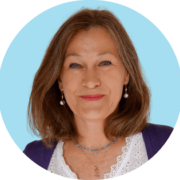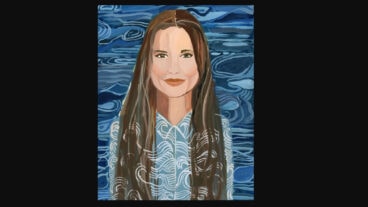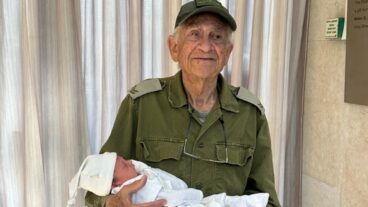When actor Christopher Reeve visited Israel last week, there was one person he insisted on meeting. The person he wanted to speak with was not a high-profile politician or fellow entertainer, but Michal Schwartz, a professor in the Neurobiology Department of the Weizmann Institute of Science in Rehovot.
For years, Reeve, who was severely paralyzed from the neck down after a horse riding accident, has been in regular contact with Schwartz. He has been following her work on the involvement of the immune system and inflammation in damage to the central nervous system (CNS) with great interest.
Reeve, who set up a foundation to raise money for spinal cord regeneration research, is only one of many people around the world who have watched with great enthusiasm as Schwartz’s research has turned into a promising treatment that could help acute spinal cord victims regain movement in their damaged limbs. Though it is still in a very early stage, Schwartz has begun work on new research that one day might offer hope to permanently paralyzed patients like Reeves, who suffered their spinal injuries years ago.
Though Schwartz, who holds the Maurice and Ilse Katz Chair of Neuroimmunology, is now recognized as a key player in the field of CNS regeneration research, her journey has not always been easy. Throughout her brilliant career, she has won many prizes, but has also managed to stir up a great deal of controversy. When she first published her groundbreaking research on auto-immune cells, for instance, one resentful colleague told her that she should have taken the research, hidden it in a drawer, and forgotten all about it. With typical
single-mindedness, Schwartz ignored his advice and went on to produce several more influential reports that have helped transform the way the world views the immune system.
Schwartz is not the sort of person you can ignore. Small and fiercely energetic, she tries to pack as much activity as possible into every day, always aware that she is up against the clock. Schwartz’s interest in science began at a young age, despite the fact that she was not born into an academic family.
“I didn’t have a clue what a scientist was, but I had a lot of curiosity,” admits Schwartz. At the age of 10 she was invited to take part in a
trip to the Weizmann Institute because of her strong burgeoning interest in science.
“When we first approached the institute it looked to me like a place of mystery. It made me feel euphoric.”
Schwartz pursued her studies at Hebrew University in Jerusalem, where she majored in chemistry, mathematics, and physics. She gave birth to her first child, one of four, when she was 20 years old and began working towards her Ph.D. in clinical immunology one year later in a special program. After finishing her Ph.D., she began her post doctoral work in the US, working on the CNS, which is made up of the spinal cord, brain and optic nerve. She then returned Israel and joined the faculty of the Weizmann Institute, where she became a tenured professor in 1985.
When Schwartz began started working in the CNS field, the only serious work being carried out was on lower vertebraes like fish and amphibians, animals which have the ability to heal themselves when their spinal cord is damaged. Schwartz, however, was interested in mammals, and particularly in the reasons why mammals whose spinal cords are severed or even in some cases just partially severed, suffer complete paralysis from the point of injury down.
After studying this area for some years, Schwartz began to understand that the immune system plays a pivotal role in the process of recovery following a CNS injury. Until then, the consensus was that immune cells that infiltrate the brain or the spinal cord are part of the pathology, not part of the repair, and are potentially damaging to the CNS. Schwartz discovered, however, that the immune cells, also known as macrophages, are actually part of the repair mechanism and can be brought to the site of a lesion in the CNS, to encourage repair and renewed growth of damaged nerve fibers.
In 1996, Schwartz founded a company called Proneuron Biotechnologies to turn her discoveries into a therapy. “I thought this was the only way to bring these ideas into reality,” recalls Schwartz. “The resources from private or public foundations are limited and without serious funding I knew we would never be able to establish these new and fundamental ideas.”
The decision to found Proneuron has proven itself many times, says Schwartz. “Everything we did at the Weizmann was tested again at Proneuron to make sure the findings were correct. It was the first verification that my ideas worked.”
Proneuron has now developed a microphage treatment, which has been tested on eight patients suffering paralysis after an accident. The clinical trial was completed in 2002, and showed good results on three of the patients. The most famous of these is Melissa Holley, an 18-year-old who was paralyzed from the chest down after a road accident in Colorado. In the wake of the treatment she has regained feeling below the injury, has the ability to move her toes and some leg muscles, and is learning to walk with crutches and braces.
Schwartz admits that when she saw the treatment working on animals for the first time she was elated and ran with her children to the lab to see the animals moving. With Melissa, however, she was deeply agitated and did not visit the patient until she was about to leave Israel.
“It was the most difficult moment of my career,” she admits. “I had very mixed feelings. On one hand I really wanted to help the patient as much as possible, on the other I was worried. I never saw an adverse effect on an animal, but with humans we couldn’t control the conditions of the test. We could only give one dose and
had to guess how much. There was a lot of risk in it and I was very anxious that there might be an adverse effect. I kept asking myself if maybe the trial was premature.”
As a result of her fears, it was not until some time after she knew that Melissa was fine, that she could bring herself to meet her.
“The meeting was extremely exciting, not just from the point of view of its success, but because I admired Melissa. She volunteered to be our first patient, knowing that we were still exploring dosing and that there may not be any point.”
Proneuron is now waiting to start a larger clinical trial on between 30-50 patients in hospitals across Europe and America.
In the meantime, Schwartz began to explore the role of auto-immune T-cells in the CNS. She discovered that when damage to the CNS takes place, the body sends T-cells to the site of the lesion to try to repair the problem. It was a
radical finding. Until this point, the accepted notion was that auto-immune T-cells were potentially damaging to the CNS.
“Clinicians regarded them as a disease. They were viewed as if the body was trying to attack itself and were thought to cause auto-immune diseases such as multiple sclerosis and diabetes. We discovered, however, that the body is using these cells for its own benefit.
We created a new concept – protective auto-immunity. In my view this was the most revolutionary concept we brought into the field. We told the medical community: forget what you know, auto-immunity is good. It is our day-to-day mechanism of maintaining our body. Only when there is a malfunction in it, does it cause disease.”
Schwartz maintained that by boosting the level of T-cells at the site of a CNS injury by a controlled amount, they could block the spread of injury-induced neuronal damage, and encourage better recovery after a partial injury to the
CNS. She also maintained that these T-cells could be used to treat almost any disorder of the CNS, including Alzheimer’s and Parkinson’s.
“Can you imagine the power of this finding?” asks Schwartz. “Everyone is looking for a pharmacological treatment, and we discovered a way the body can do it for itself.”
Schwartz published two papers on this subject in 1998 and 1999. They were not well received by academia. “I recruited many enemies,” admits Schwartz. “When you come up with a new idea that flouts existing dogma you can expect some resistance and skepticism. We knew that, but it’s still tough to keep going when so many people object. At the beginning I suffered a lot. I kept asking myself if I was doing the right thing. As time went by though I realized more and more pieces were being added to the puzzle, so I had less doubt about the concept. Scientists are now repeating my findings in different ways and using different paradigms, so we are getting approval that we were right, which is very pleasing.”
Proneuron is today using Schwartz’s T-cell research to develop an innovative clinical treatment to prevent total paralysis after partial spinal cord injury.
Schwartz has also made significant discoveries in the field of glaucoma, an optical nerve condition thought for many years to be a disease caused by intra-ocular pressure. Schwartz suggested that glaucoma is actually a slowly
progressing neuro-degenerative disease, that can benefit from treatments designed for other neuro-degenerative diseases.
“It took real chutzpah (daring) for us to suggest this because our knowledge of glaucoma was almost zero,” admits Schwartz. Before long, however, the scientific community began to verify Schwartz’s assertion.
On the basis of her findings, Schwartz developed a method of boosting the body’s immune system without risking auto-immune disease. She showed that Copaxone, a drug developed by Teva Pharmaceuticals that induces a beneficial autoimmune response, can be used as a vaccine that protects the optic nerve from neuronal
degeneration. Teva has signed an agreement with Proneuron to explore the use of Copaxone for glaucoma and other neuro-degenerative diseases. Clinical trials should begin next year.
While Schwartz admits that much of her career has been isolated because of the scepticism her theories provoked, she also acknowledges that being a woman in a man’s world makes the experience tougher, and even more so as a mother.
“Israel is not the center of the world, and definitely not the center of the scientific
world. If you want to remain at the top you have to travel a lot. This is very demanding as a mother with four kids. I get to a place last and am the first to leave. I fly nights to save days. This might not be the healthiest lifestyle, but I have to do it. In my life there’s either science or the kids. There’s
nothing in between.”
As a result of this, Schwartz, whose youngest child is 10, is tough with her own female students. “There are many difficulties as a mother, but the last thing I want to hear a student say is that a babysitter didn’t come, or the baby was sick. You have to find a solution between you and your partner and not to bring these problems to work.”
Despite all her past achievements, Schwartz still has many important goals for the years ahead.
“From a conceptual point of view auto-immunity is the crossroads of many diseases,” says Schwartz, with clear excitement. “The mechanism
in our bodies is simpler than we thought and our discoveries about auto-immunity may lead us to even more breakthroughs in the next few years. I’m always concerned that despite what I have already achieved in the last 20 years, I don’t have enough years to accomplish what I still want to do.”
One of the first tasks she has set herself is to try to find a treatment for chronically-disabled patients like Reeve, who Schwartz has met before and greatly admires.
“Reeve did not coming to be treated, he knows he cannot be treated, but he does hope that with momentum and effort we will be able to develop a second generation of therapy for chronic patients. We are working hard on this in my lab. It is still in its infancy, but lately the field has moved so far that nothing is impossible at this stage,” says Schwartz.
If Schwartz does find a treatment it will be a tremendous breakthrough with far reaching consequences. By her own admission, however, it will probably still not be enough.
“That’s what drives me forward all the time. I feel what I have done so far is important, but not enough.”













